Skyscraper city
For architecture fans, Chicago is the place to walk and gawk.
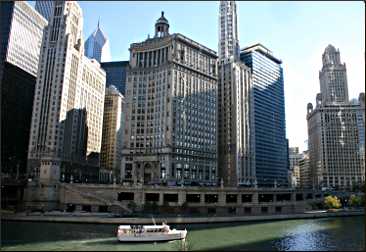
© Beth Gauper
In Chicago, there's great people-watching — but the building-watching is even better.
The city is best known for humongous buildings — the Willis (Sears) Tower, 875 N. Michigan Ave. (the Hancock Center), the Aon Center. But clustered around their knees are others that attract tourists from all over the world, buildings with so much flair it's tempting to give them personalities.
There's Helmut Jahn's Thompson Center, the brassy showgirl with the heart of gold, and Ludwig Mies van der Rohe's Federal Plaza, the geek with the thick black glasses.
Two Prudential Plaza is Miss Congeniality — Chicagoans were so bored by Pru One that the company made Pru Two a twin of the beloved Chrysler Building in New York. Philip Johnson's slick 190 South LaSalle is a yuppie with too much money.
There's no sense being overly reverent about Chicago architecture; Chicagoans themselves argue about it all the time. And who cares if the guy who designed all those boxes is the greatest architect of the 20th century?
I'm not exactly an idiot about architecture, which is to say I know a dentil from a lentil — though, in truth, the two look much alike when put in rows.
But after a few trips to Chicago, I was wondering: Why is Mies van der Rohe so revered? What exactly is post-modernism? Is that big red library old or new?
So I turned myself over to the volunteer guides of the Chicago Architecture Center, who crisscross the city trailing flocks of students. My first guide was Mary Gerding, to whom I confessed my undeveloped palate for the glass-and-steel boxes of the International style.
Luckily, she seemed to understand.
"As I've learned more, I like it more," Gerding said. "Before, I would've walked through the Federal Plaza and thought, 'Huh.' "
One Friday in June, 35 of us showed up at foundation headquarters on Michigan Avenue for the two-hour Modern Skyscrapers tour, one of dozens offered by foot, boat, bike, train and bus.
I attached myself to the group led by Gerding, who explained the important dates in Chicago's architectural history.
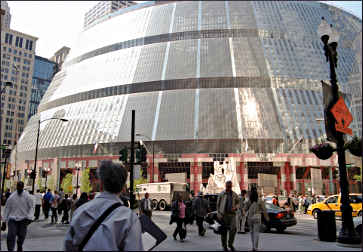
© Beth Gauper
In 1871, the city burned and had to be rebuilt, and in 1893, architects vied to build pavilions for the Columbian Exposition, which brought 27 million visitors to town.
In 1955, the first "big" building went up after the architectural drought of the Depression and Second World War.
On our way into the Loop, she pointed out the 1990 Pru Two, a post-modern reaction to the severely boxy modernism of 1955's Pru One, and the 1974 Aon Building, object of local derision because it began shedding its marble skin less than a decade after it was built.
And we pondered the 1991 Harold Washington Library Center, built in the Beaux-Arts civic style popular a century earlier, but with modernist touches in its glass-and-steel attic and post-modern ornaments capping its corners like Cubist gargoyles.
"That's one thing the post-modernists will do, is take a decoration and blow it out of scale," Gerding said.
Then we walked down Dearborn to Federal Plaza, built by Mies van der Rohe, a German-born anti-Speer who rejected the fussiness and pomposity of classical and Beaux-Arts edifices.
"He thought beauty was in simplicity of scale, and the quality of the materials used," she said. "He's often quoted as saying, 'Less is more,' and 'God is in the details.' "
We all gazed at the building, black I-beams clamped all over its glass surface. There was another glass box next to it, and a third across the street: Huh.
The 1957 Inland Steel Building was a glass box, too, but elegantly clad in stainless steel across which light moved in shimmering waves. That was a box we could love: "It's a favorite," Gerding confirmed. "I love that building."
We moved on to Bank One, a curving glass tower that seems to flare out at the top, and to the Daley Center, with a Picasso sculpture that the architects finally coaxed out of the famous artist through gifts of Cubs, White Sox and Bears trophies and an American Indian headdress.
And then we came to Helmut Jahn's 1985 Thompson Center, a glass hut with coral and turquoise panels and a plaza that features a disappearing archway and a Jean Dubuffet sculpture that locals call "Snoopy in a Blender."
Inside, shops and offices ringed a 17-story atrium.
"It's been described as visually noisy," Gerding said. "But a lot of people love this building. It's like a building for the common man; you don't feel you have to be dressed in a three-piece suit."
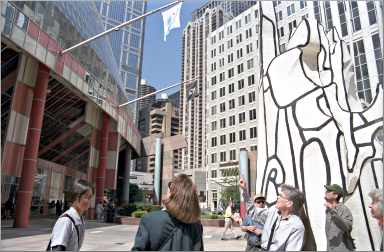
© Beth Gauper
Hmmm. Later, on the foundation's lakefront bike tour, I heard that ventilation problems at the Thompson Center turn it into an oven, and that, at a volunteer dinner there, rain from the leaking roof fell on Jahn's table.
On the river cruise, I found out that Jahn himself worked in a little domed aerie atop the 1926 Jewelers Building, a neo-baroque tower on the river.
In Chicago, locals have taken architecture seriously ever since the sale of its first home, built by black trader Jean Baptiste Point du Sable after his arrival in 1779.
"John Kinzie bought the du Sable shack, added pillars to the front and called it the Kinzie Mansion," said guide Don Wiberg. "That started the trend of everything in Chicago having to be the biggest and the fanciest."
Wiberg and his wife, Joyce, wearing "The City Is Our Museum" shirts, were our guides on the three-hour Lakefront by Bike tour.
We started at the 1916 Navy Pier, reopened in 1995 with a Ferris wheel, carousel, shops, restaurants and cruise-boat moorings and now hugely popular.
From there, we rode beyond the Ohio Street Beach to Olive Park, where we gazed upon glittering buildings lining a shore that was underwater until a character named George Streeter paid contractors to dump their debris there and then, with his new land, seceded from the city.
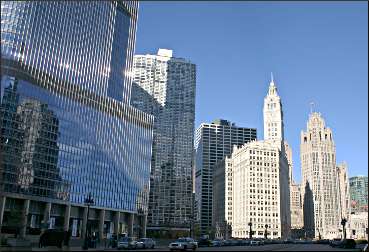
© Beth Gauper
We rode past the lock that controls the flow of Lake Michigan, source of the city's drinking water, into the Chicago River. The river, also the city's sewer, flowed into the lake until residents began dropping dead of cholera, and in 1900 the river was reversed.
We rode all the way to Grant Park, known as "Chicago's front yard," where the annual Blues Fest was in progress.
There, the Wibergs told us how Montgomery Ward spent 20 years fighting the city and his fellow businessmen to keep the lakefront open to the public, and about the next-door Millennium Park, with its Frank Gehry-designed bandshell, super-popular sculptures and pedestrian bridge.
"Nothing is ever finished in Chicago," Don Wiberg said wistfully. "It makes you want to live to be 150 to see it all."
I got another view of the city from the top deck of Chicago's Little Lady, one of the launches on which the Architecture Center gives its popular 1½-hour river cruises.
With guide Karen Luckritz at the helm, we traveled all the way from 1673, when Marquette and Joliet took a shortcut back to Lake Michigan on the Chicago River, to 1964, when the corn-cob Marina City apartments were built as a response to urban flight.
Today, suburban dwellers are fleeing back, snapping up riverside condos and lofts in converted warehouses and offices.
"There's huge demand," she said. "Everyone wants to live here, so close to the Loop."
Along the way, we could see how Chicago became the stage on which American architectural aesthetics evolved. We saw the neo-Gothic Tribune Tower, based on Rouen Cathedral and the winner of an international design competition held in 1922.
We saw the sleeker Art Deco tower based on Eliel Saarinen's second-place entry and the dark curtain wall of the 1971 IBM Building, Mies van der Rohe's last glass box.
"After Mies came in 1938, we had no more references to monarchies and cathedrals," Luckritz said.
Those are back now, enlivening Miesian frames with Beaux-Arts pediments and Art Deco curves and Prairie-style urns. Post-modern is the order of the day, although, this being Chicago, anything goes.
I'm still no expert on architecture. But thanks to my crash course, I now see that Chicago's glittering skyline is much more than a pretty face.
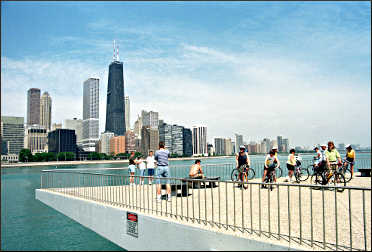
© Beth Gauper
Trip Tips: Chicago architecture tours
Visitors who plan to visit the center and go on a walking tour and a river cruise will save by buying a Chicago Architecture Center membership, $80 individual, $110 for two adults.
Tour themes change continually, and tours often sell out.
River tours: From May through late November, 1½ hour Chicago Architecture Foundation River Cruises are held several times daily from the Michigan Avenue Bridge.
Tickets should be reserved in advance for summer weekends, either at the CAF centers, river ticket booth, city visitor centers or from TicketMaster.
Wendella Boats also gives a daily 75-minute Chicago River Architecture Tour. The dock is at the Michigan Avenue Bridge.
Walking tours: Some tours are held year-round, including those on modern and historic skyscrapers.
Others, on less-frequent schedules, take visitors to dozens of locations and neighborhoods, including Streeterville, Logan Square, Michigan Avenue, Printers Row and the Gold Coast, as well as Evanston and various cemeteries.
In warmer months, there are pub crawls in five neighborhoods (beer not included).
Most tours are $30, free for members. Tours start from the Chicago Architecture Center.
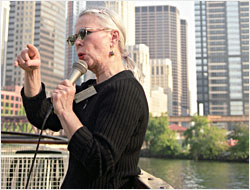
© Beth Gauper
Train: Two-hour tours explore the city via the El.
Bus tours: There are many bus tours, covering such topics as churches, bungalows and parks and boulevards and Frank Lloyd Wright neighborhoods. Members get a discount.
Chicago Architecture Center: The former Chicago Architecture Foundation now shares a name with its new center, in a 1970 building designed by the office of Ludwig Mies van der Rohe at 111 E. Wacker Drive, just off Michigan Avenue on the river. Admission is $7, free for members, and is included in the price of tours.
Exhibits include scale models of famous skyscrapers and the Chicago City Model Experience, featuring more than 4,000 local buildings with a film and light show.
It also has a large gift shop filled with beautiful designed things.
Oak Park: In the western suburb of Oak Park, the Frank Lloyd Wright Trust offers guided tours of Wright's home and studio and the Prairie-style buildings of the historic district.
The CTA Green Line goes right to Oak Park from downtown.
From its center, the Architecture Foundation also offers four-hour bus tours to Wright buildings in Oak Park.
For more, see Wright in Oak Park.
Planning a trip to Chicago: For information on hotels, dining and other tours and attractions, see Chicago stories.